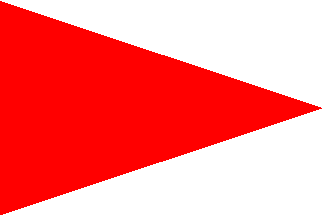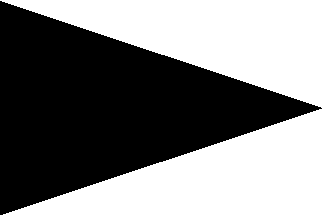Beach flags (Argentina) (original) (raw)

This page is part of © FOTW Flags Of The World website
Last modified: 2020-07-26 by francisco gregoric
Keywords: argentina | beach | [monte hermoso](keywordm.html#monte hermoso) | [partido de monte hermoso](keywordp.html#partido de monte hermoso) | [lago lacar](keywordl.html#lago lacar) | [provincia del neuqu�n](keywordp.html#provincia del neuqu�n) |
Links: FOTW homepage |search | disclaimer and copyright | write us | mirrors
See also:
Sea beaches flags
According to the Comission of Lifeguards of the Province of Buenos Aires, apparently, in the early decades of the twentieth century, in the city of Mar del Plata, a system of beach flags, similar to the present one, came into use. It was later adopted throughout the Province of Buenos Aires. This use then extended to sea beaches from other provinces.
These Argentine beach flags, although called "banderas" (flags), are really triangular pennants.
Francisco Gregoric, 03 Feb 2015
Light blue flag - Sea in good condition to swim

by Francisco Gregoric, 02 Feb 2015
The light blue pennant means "Mar bueno" literally "Good sea", that means that the sea is in good condition to bath and swim. Technically speaking this means "soil without sand drifts without causing currents sucks".
Francisco Gregoric, 03 Feb 2015
Yellow and black flag - Doubtful sea
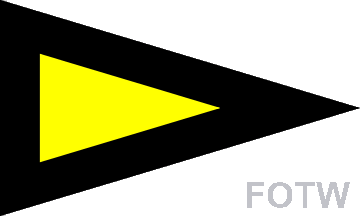
by Francisco Gregoric, 03 Feb 2015
The yellow and black pennant means "Mar dudoso" literally "Doubtul sea" that means that the conditions are not as perfect as with the light blue pennant. Technically speaking this means "possible existence of probable irregularities in the motion of the tide or sand covering the bottom".
The pennant usually used nowadays is a black one with a smaller yellow triangle inside. It is the most common used in the Buenos Aires Province beaches and the officially prescribed and used one in the beaches of the city of Rawson (in the Chubut Province). However there are variants of this beach yellow and black pennant.
Francisco Gregoric, 03 Feb 2015
Variants of the yellow and black flag
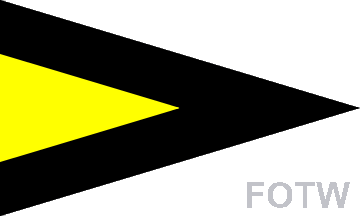
by Francisco Gregoric, 03 Feb 2015
In one of the most common variants, the internal yellow triangle is located next to the hoist.
Francisco Gregoric, 03 Feb 2015
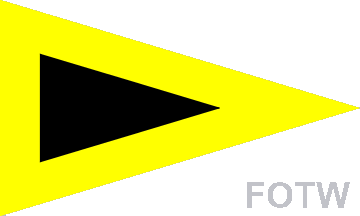
by Francisco Gregoric, 03 Feb 2015
This variant has inverted colors: a yellow triangle with a smaller black triangle inside. This one sometimes appears in the beaches of the Buenos Aires Province.
Francisco Gregoric, 03 Feb 2015
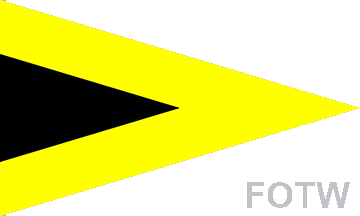
by Francisco Gregoric, 03 Feb 2015
Similar to the previous one, but the internal black triangle is located next to the hoist.
Francisco Gregoric, 03 Feb 2015
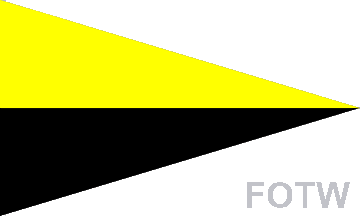
by Francisco Gregoric, 03 Feb 2015
This variant has two yellow and black horizontal stripes. It is not very used nowadays.
Francisco Gregoric, 03 Feb 2015
Red and black flag - Dangerous sea

by Francisco Gregoric, 03 Feb 2015
The red and black pennant means "Mar peligroso" literally "Dangerous sea" that means that the conditions are not good to bath and swim. Technically speaking this means "Existence of wells, or suction channels produced by the breakdown of the sandbanks".
The pennant usually used nowadays is a red one with a smaller black triangle inside. This is the most usually seen in the Buenos Aires Province beaches. However there are variants of this beach red and black pennant.
Francisco Gregoric, 03 Feb 2015
Variants of the red and black flag
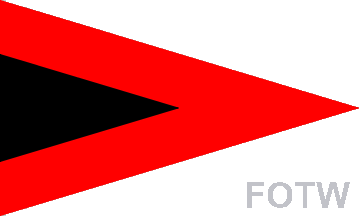
by Francisco Gregoric, 03 Feb 2015
In one of the most common variants, the internal black triangle is located next to the hoist.
Francisco Gregoric, 03 Feb 2015
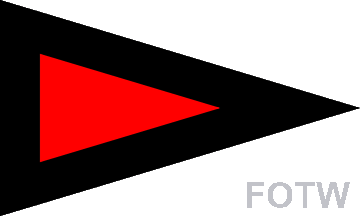
by Francisco Gregoric, 03 Feb 2015
This variant has inverted colors: a black triangle with a smaller red triangle inside. This one rarely appears in the beaches of the Buenos Aires Province. However it is officially prescribed and used in the beaches of the city of Rawson in the Chubut Province.
Francisco Gregoric, 03 Feb 2015

by Francisco Gregoric, 03 Feb 2015
Similar to the previous one, but the internal red triangle is located next to the hoist.
Francisco Gregoric, 03 Feb 2015
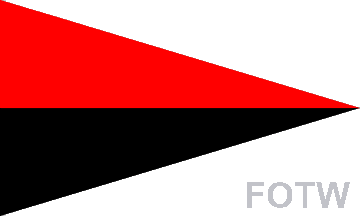
by Francisco Gregoric, 03 Feb 2015
This variant has two red and black horizontal stripes. It is not very used nowadays.
Francisco Gregoric, 03 Feb 2015
Red flag - Forbidden to swim
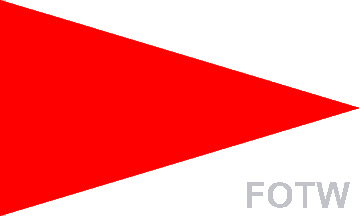
by Francisco Gregoric, 03 Feb 2015
The red pennant means "Prohibici�n de ba�o" literally "bathing prohibition". Therefore it is forbidden to enter the sea. Sometimes it has to do with the conditions of the sea or pollution or any other one decided by the lifeguards, for example when there is a competition in the sea.
Francisco Gregoric, 03 Feb 2015
White flag - Kid lost
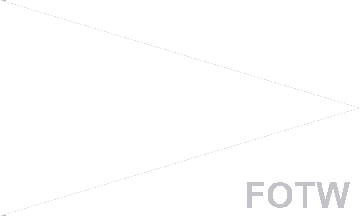
by Francisco Gregoric, 03 Feb 2015
The white pennant means "ni�o perdido" (kid lost). It is a much newer pennant than the previous ones.
It is raised bellow the one that indicates the condition of the sea (light blue, yellow & black, red & black or red) to indicate the presence there of a kid, previously lost, found by the lifeguards.
Francisco Gregoric, 03 Feb 2015
Black flag - Lightning storm (leave the sea and beach)

by Francisco Gregoric, 03 Feb 2015
In January 2014, there was a tragedy in a beach located in the city of Villa Gesell (in the Province of Buenos Aires), when four people died and many were injured by a lightning strike on the beach during a sudden thunderstorm.
A few days later another lightning struck on a beach in the city of Mar del Plata wounding several tourists.
After these two events, it was decided to add a new indicative flag for the beaches of the Province of Buenos Aires: a black pennant with the representation of a white lightning bolt inside. This flag indicates that all present people must leave the sea and the beach.
Francisco Gregoric, 03 Feb 2015
Lightning storm flag proposal (Monte Hermoso District)
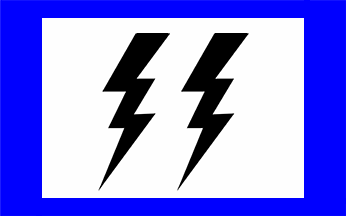
by Francisco Gregoric, 03 Feb 2015
Soon after the 2014 tragedies with lightning storms in Argentine beaches, the District of Monte Hermoso (in the Province of Buenos Aires) proposed a special flag for warning about lightning storms. This flag was used soon after in Monte Hermoso beaches. However the government of the Province of Buenos Aires chose to use the black flag for lightning storms in the whole province. Therefore this flag was just used in 2014, only in Monte Hermoso District beaches.
It was a white rectangular flag with a narrow blue border. At center, two black lightning bolts appeared.
Francisco Gregoric, 03 Feb 2015
Other sites:
- Explanation about Argentine beach flags at the website of the Comission of Lifeguards of the Province of Buenos Aires
- Beach flags chart at the website www.diariolaplaya.com.ar
- Signal [beach] flags chart at the website www.santateresita.com.ar
- Beach flags chart at the website www.alquileres-gesell.com.ar
- Municipal Ordinance No. 4605 (1998) of the city of Rawson defining beach flags at the Rawson Municipal Council official website
- Municipal Ordinance No. 5706 (2004) of the city of Rawson defining lifeguards activities and beach flags at the Rawson Municipal Council official website
- Flag for lightnings at the website of the newspaper P�gina 12
- Flag for lightning storm photo and article at the website of the newspaper Cr�nica
- The beaches of Villa Gesell will use a flag for lightning storms at the website of infogei.com.ar
- Alert flags for lightning started to be used in beaches at the website of www.diarioregistrado.com
- A flag for lightning in beaches is created in Monte Hermoso at the website of www.lanoticia1.com
- Monte Hermoso presented its flag for lightning storms at the website of infocielo.com
- Monte Hermoso was a pioneer in using a flag for lightning storms at the website of www.lu24.com.ar
reported by Francisco Gregoric, 03 Feb 2015
Lake Lacar beach flags
"Diario R�o Negro" reported on 19 January 2007 the closure of the beaches of Lake L�car [located inside the Province of Neuqu�n] after the accidental release into the lake of a huge quantitiy of faeces-loaded water by the water-treatment plant of San Martin de Los Andes. There is a black and white photography of the information shield, from which I have extracted the following information.
The three warning flags are prescribed by an Ordinance on the quality conditions of water for recreative use - bathing waters.
Ivan Sache, 20 Feb 2007
These beach flags used in Lake Lacar are different from the ones used in Argentine sea beaches.
Francisco Gregoric, 03 Feb 2015
Blue flag - Authorized beach
Red flag - Non authorized beach
Black flag - Hazard for health, swimming prohibited
These flags do not seem to refer to weather conditions but only to the quality of the water.
Ivan Sache, 20 Feb 2007
Other sites:
- The beach of Lake Lacar was closed for contamination at the website of www.rionegro.com.ar
reported by Ivan Sache, 20 Feb 2007
Anything below this line was not added by the editor of this page.

